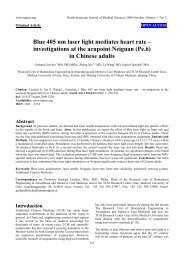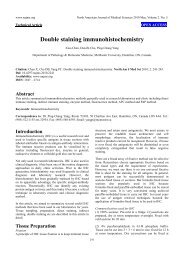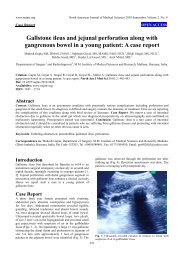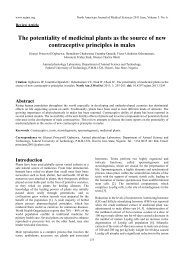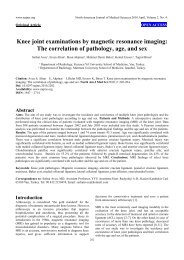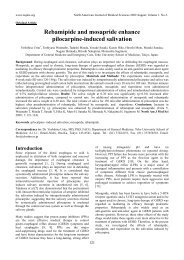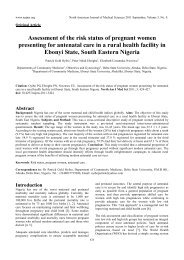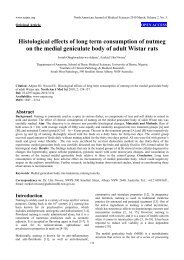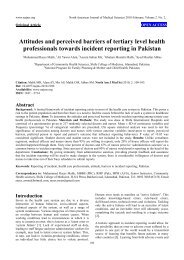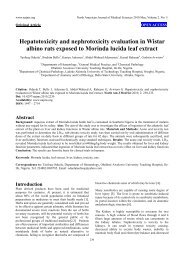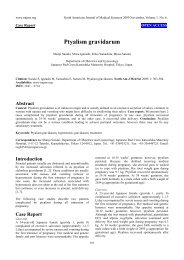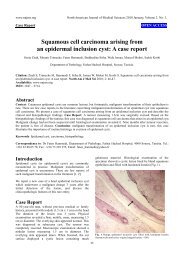Pleomorphic adenoma of the lower lip - North American Journal of ...
Pleomorphic adenoma of the lower lip - North American Journal of ...
Pleomorphic adenoma of the lower lip - North American Journal of ...
Create successful ePaper yourself
Turn your PDF publications into a flip-book with our unique Google optimized e-Paper software.
www.najms.org <strong>North</strong> <strong>American</strong> <strong>Journal</strong> <strong>of</strong> Medical Sciences 2011 June, Volume 3. No. 6.<br />
(Figure 3). The patient recovered uneventfully and clinical<br />
follow-up for 40 months after resection exhibited no<br />
evidence <strong>of</strong> local recurrence or o<strong>the</strong>r occurrence on <strong>the</strong><br />
head and neck and <strong>the</strong> o<strong>the</strong>r parts <strong>of</strong> <strong>the</strong> body.<br />
Fig. 1 Exploration <strong>of</strong> <strong>the</strong> mass after a transverse incision, parallel<br />
to <strong>the</strong> inferior border <strong>of</strong> <strong>the</strong> <strong>lower</strong> <strong>lip</strong>.<br />
Fig. 2 The size <strong>of</strong> <strong>the</strong> long axis <strong>of</strong> <strong>the</strong> resected mass is seen as 1.5<br />
cm in diameter.<br />
Fig. 3 The glandular structures having basal myoepi<strong>the</strong>lial<br />
components on <strong>the</strong> chondromyxoid background (Haematoxylin<br />
and Eosin, Original magnification, 5x10) .<br />
Discussion<br />
The most common tumor <strong>of</strong> minor salivary glands,<br />
accounting 40 %, may be found in larynx, nasal cavity,<br />
and paranasal sinuses. In <strong>the</strong> term <strong>of</strong> extra-major salivary<br />
gland pleomorphic <strong>adenoma</strong>, <strong>the</strong> most frequent occurrence<br />
was reported as palate, followed by upper <strong>lip</strong>. <strong>Pleomorphic</strong><br />
<strong>adenoma</strong> <strong>of</strong> minor salivary glands mostly seen in female<br />
gender [3]. So, we purposed to present a pleomorphic<br />
<strong>adenoma</strong>, located on <strong>the</strong> <strong>lower</strong> <strong>lip</strong> and found in a male.<br />
This location is a rare site <strong>of</strong> occurrence for pleomorphic<br />
<strong>adenoma</strong>. Al-Khateeb et al [1] evaluated <strong>the</strong> relative<br />
frequencies, types and distribution <strong>of</strong> benign oral masses<br />
in <strong>North</strong> Jordanians. A total <strong>of</strong> 818 cases with benign oral<br />
s<strong>of</strong>t tissue masses retrospectively analyzed for an 11-year<br />
period and <strong>the</strong> parameters <strong>of</strong> age, sex, mass type and<br />
location were measured. Common benign neoplasms were<br />
salivary pleomorphic <strong>adenoma</strong> and <strong>lip</strong>oma. Most frequent<br />
non-neoplastic lesion was traumatic (43%). Male to<br />
female ratio and <strong>the</strong> mean age was detected as 1:1.5 and<br />
33 years, respectively. The palate, tongue, upper <strong>lip</strong> and<br />
buccal mucosa, were <strong>the</strong> sites commonly affected by<br />
benign neoplasms in a descending order. Of 818 cases a<br />
sum <strong>of</strong> 13 pleomorphic <strong>adenoma</strong> (2%) were determined,<br />
mostly in <strong>the</strong> patients between <strong>the</strong> ages <strong>of</strong> 21-30 years<br />
(6/13). The cases <strong>of</strong> pleomorphic <strong>adenoma</strong> were located<br />
mostly in <strong>the</strong> palate (8/13). Three <strong>of</strong> <strong>the</strong>m was on <strong>the</strong><br />
upper <strong>lip</strong> and only one found in <strong>the</strong> gingiva (1/13) and one<br />
in <strong>the</strong> <strong>lower</strong> <strong>lip</strong> (1/13). In general, only one patient (1/818)<br />
was <strong>the</strong> case <strong>of</strong> pleomorphic <strong>adenoma</strong> <strong>of</strong> <strong>the</strong> <strong>lower</strong> <strong>lip</strong> in<br />
that wide analysis <strong>of</strong> benign oral masses in a <strong>North</strong><br />
Jordanian population during an 11-year period. According<br />
to our knowledge, <strong>the</strong> number <strong>of</strong> <strong>the</strong> cases <strong>of</strong> pleomorphic<br />
<strong>adenoma</strong> <strong>of</strong> <strong>the</strong> <strong>lower</strong> <strong>lip</strong> which were presented in <strong>the</strong><br />
literature, indexed in Medline have been a very limited<br />
number. Besides, our case is <strong>the</strong> first case from Turkey<br />
among <strong>the</strong> mentioned literature [4].<br />
In <strong>the</strong> treatment <strong>of</strong> pleomorphic <strong>adenoma</strong>, wide resection<br />
with negative margins is frequently recommended as an<br />
optimal choice. Because, almost half <strong>of</strong> all tumors<br />
originating from minor salivary glands are proclaimed as<br />
malignant. So, even fine-needle aspiration or incisional<br />
biopsy was suggested before <strong>the</strong> definitive surgery.<br />
Additionally, a recurrence rate <strong>of</strong> 2-44 % has been<br />
declared in <strong>the</strong> literature since 1939 [3]. Krolls et al [5]<br />
asserted that inefficient first surgical intervention was <strong>the</strong><br />
main cause <strong>of</strong> recurrences. However, Dongre et al [6]<br />
propounded that simple excision was <strong>the</strong> only treatment<br />
for it. Disadvantages <strong>of</strong> wide excision <strong>of</strong> extra-major<br />
salivary gland pleomorphic <strong>adenoma</strong> may be summarized<br />
as cosmetic care particularly for upper and <strong>lower</strong> <strong>lip</strong>s, eyes,<br />
and face in general, and probability <strong>of</strong> injury to functional<br />
structures <strong>of</strong> head and neck such as upper and <strong>lower</strong> <strong>lip</strong>,<br />
and palate. So, we and <strong>the</strong> patient choiced just a total<br />
excision for <strong>the</strong> mass <strong>of</strong> <strong>the</strong> presented case due to some<br />
cosmetic reasons. The patient recovered uneventfully and<br />
no recurrence was observed during a clinical follow-up for<br />
40 months. However, we <strong>of</strong>fer wide excision for <strong>the</strong><br />
treatment <strong>of</strong> extra-major salivary gland pleomorphic<br />
<strong>adenoma</strong> especially for <strong>the</strong> selected cases.<br />
In summary, tumors <strong>of</strong> <strong>the</strong> minor salivary glands are<br />
uncommon among entire salivary glands tumors.<br />
300



